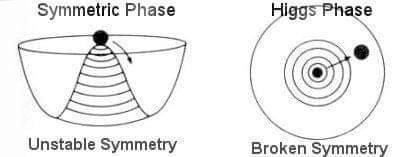There is a problem with every kind of integration. The phenomenon you hope to collect would not be a surprise if it weren’t so different. This work would have already been done. The big question is why they look different.

If the sun is a star, then why does it look so different from the stars? This claim would seem ridiculous without understanding the reason (distance).
Einstein responded strongly to his idea of unification with the help of the Observer’s point of view. Apparently the differences are due to the state of the observatory, not to the phenomenon itself. Electricity and magnetism, motion and calm, gravity and acceleration were combined in this way.
Another new principle was proposed behind the unification of forces, which was to break the symmetry. To understand this we take the example of the laws of our world.
Our social laws apply equally to everyone. This feature of any good society will be called the symmetry of law. Replace one person with another, the same rules will still apply. Everyone has to pay taxes according to the rules. Do not drive faster than the prescribed speed limit. These laws are the same but can have their own characteristics.
One person’s income may be higher than the other. One person may not have a car. The laws are the same, but when the law is applied to another person, the result is not the same. A person’s personality determines what the consequences will be. Which law will be relevant or not?
In an ideal society, everyone started from an early stage. Unfortunately this is not the case, but we can say that the initial opportunities were symmetrical. As life progressed, this initial symmetry became limited. The symmetry must be broken. But how does it break? It cannot be stated. This principle of spontaneous symmetry breaking is the second major principle of the physics standard model.
Another example to understand this: Suppose a new class has come to a university. Students do not know each other. They will meet each other, they will be friends, they will be groups. (Some may even marry each other). It will be a network of relationships. On the first day, when they all met as strangers, the group was very symmetrical. Relationships could have been formed in many ways, but in fact only one of them was realized. Symmetry was not stable. In the real world, lumbering elephants are exposed by the aggression of speeding midgets. From the unstable state of freedom of possibility to the stable experience of reality.
The same is true in physics. An example is given if a pencil is placed on the tip of a coin. It is now in symmetry. Can go in any direction. But the situation is not stable. It has to fall. how does? It will be random. Whichever way it falls, the symmetry will break. Once it falls, it is stable, but it is no longer symmetrical. But the laws behind it are still symmetrical. That is, they did not have a particular direction. The rules only describe the space of possibility.
In the real world, realization is one of many possibilities.
This mechanism of symmetry breaking can also break the symmetry of particles in nature. When the symmetry of the gauge principal is broken, then the forces of nature are born with different characteristics. Their range may vary. There may be a difference in strength. Until the symmetry was broken, the range of all forces was unlimited, but later it became limited to nuclear forces.
This principle was one of the most important conceptual discoveries of twentieth century physics. Because this gauge could have combined the seemingly separate fundamental forces with the principal.
The combination of these two principles was invented in 1962 by Frenchman Engert and Robert Braut in Brussels. And a few months later, Peter Higgs went to the University of Edinburgh independently. It was named Higgs Phenamina. All three showed that the idea of the collapse of the symmetry resulted in the prediction of a particular field called the Higgs field and could be experimentally verified with a single particle. This particle is the Higgs boson. (Higgs was the last particle of the boson standard model whose existence was confirmed experimentally).
On the way to the completion of the standard model, the next big discovery was made by Pakistani scientists Abdul Salam and Weinberg. It was a combination of the two forces, but more importantly, their work was the first to predict the two basic principles of the standard model.
